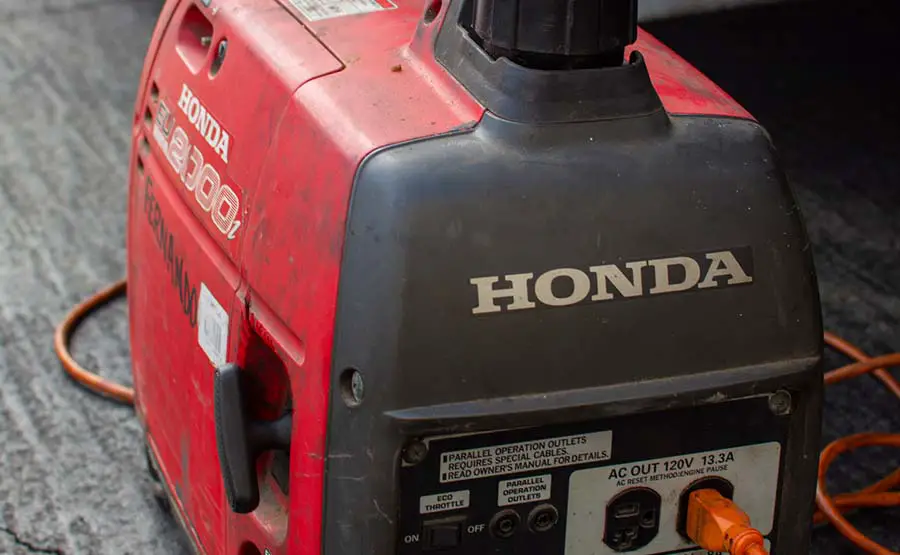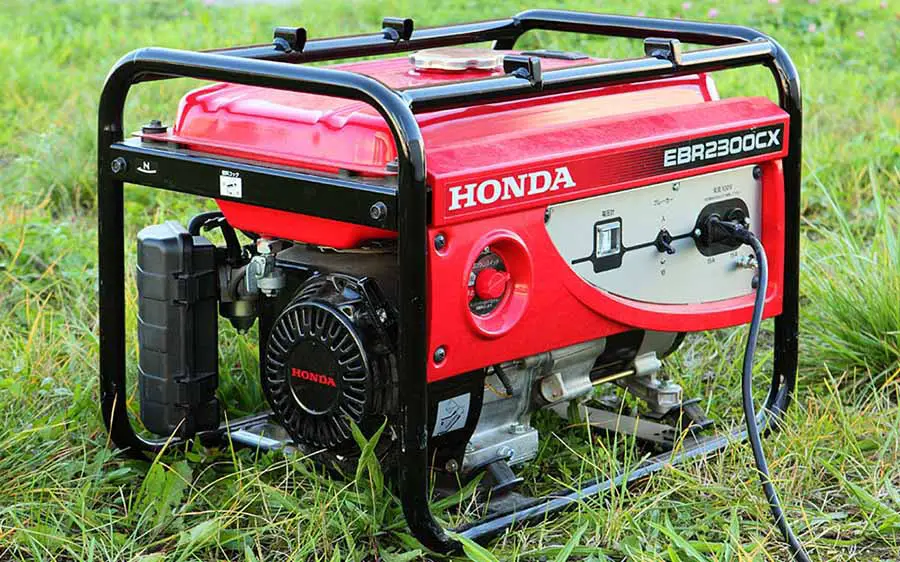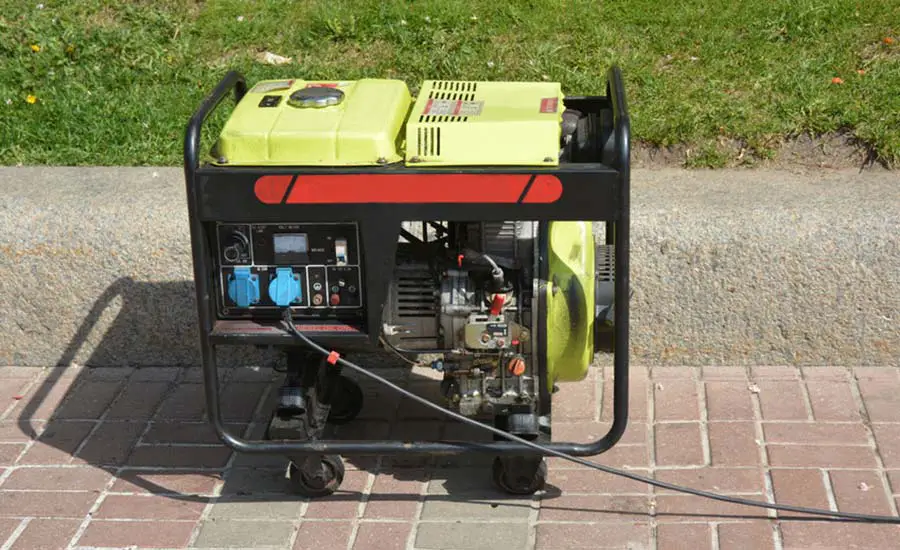
Often, it is heavy rains and storms that cause power outages. In such instances, using generators becomes inevitable as they are imperative in maintaining a power supply. But among the cardinal questions about generators use is whether you can run them in the rain.
You cannot run a Honda generator in the rain without additional protection or cover because it will likely short circuit and shut off. There are many options when protecting a generator from the rain, including steel structures, generator covers, sheds, pop-up canopies, or custom-made enclosures.
You will often want to run your generator while it’s raining. We will highlight some of the hacks of making it possible without putting the generator at risk of destruction. Hence, keep reading.
Can a Honda Generator Get Wet?
A Honda generator will get wet when exposed to rain as it is not waterproof. You might find some models labeled as safe for use in wet weather, however it isn’t advised to use a generator in the rain without some coverage.
Also, note that a wet generator is risky. It can electrocute you and also destroy the generator via short-circuiting.
Since generators can get wet, it is imperative to apply some key measures to protect them from coming into contact with water. It seems logical to run a generator in the house when it’s raining as it will be safe from water. Nonetheless, such a move will be suicidal, as we will explain later.
Can You Run a Generator in the Rain?
You can run a generator in the rain, but you must protect it from direct contact with the rainwater.
Ideally, a generator is designed to create electricity and supply it to other components. Electric current is dangerous in the presence of water. Hence, you cannot run the engine while the generator gets wet.
It is not only rainwater that is dangerous. Even exposure to snow will lead to problems for the generator as snow is also water.
Some generators feature ground fault circuit interrupter (GFCI) systems. A GFCI will identify the presence of a water interference and prompt the shutting down of the generator. It aims to mitigate the problem that rainwater exposure can cause.
Can a Generator Get Wet and Still Work?
A generator will not work if it gets wet. One may wonder how this could be possible, yet a similar machine like a car will continue operating even in the rain. While they could be similar in some aspects, the generator is different as it does not have full coverage like a car.
Ideally, the generator’s engine is similar to that of a car. The combustion systems are also similar. But the car’s critical parts are covered. On the other hand, a generator is quite exposed. It is why we are advocating for protecting it when running in wet weather.
Contact with water will cause damage to some critical parts of the engine, causing it to stop working. Hence there are particular parts of the generator that you should protect from getting wet. Let’s look at the effect of water on these parts.
Air Inlet
As the name suggests, the air inlet is the channel through which the generator draws air. The air is imperative in supporting combustion in the generator’s combustion chambers. Consequently, the generator produces mechanical energy, which in turn generates electricity.
The air inlet is supposed to allow only the entry of air. It has filters to prevent dust and other particulate matter from entering. However, the filters will not prevent water from entering. If water gets in through the air inlet, it will travel down to the combustion chamber.
The presence of water in the combustion chamber will inhibit combustion. Hence, the generator will not run.
Exhaust
The other exposed part through which water can enter the generator is via the exhaust. The exhaust connects to the combustion system like the air inlet. Hence, if water enters the generator via the exhaust, it will affect combustion.
Spark Plug
A generator’s spark plug is essential in combustion as it provides the ignition to burn the fuel. Hence, contact of the spark plug with water will cause it not to function effectively. Without a spark plug in a petrol generator, it will not run.
Do You Need to Protect Your Generator From Rain?
You need to protect your generator from the rain. However, it is also essential to uphold several safety precautions as you do so. Often, many accidents happen because of running generators so close to the house to protect them from the rain.
During Hurricane Sandy, carbon monoxide poisoning caused several deaths. It demonstrates you are significantly risking your life if you put your generator too close to your house or inside.
When there is a power outage, you in such conditions Itare in such conditions Itexpect chaos and panic as people seek to fix the power back. During this state of disorder, accidents and life-endangering mistakes regarding generators can happen.
The following are some critical generator usage mistakes and ways to prevent them.
Placing a Running Generator Close to the Home
Stationary generators require some distance from any houses or structures for safety reasons, ideally, at least 20 feet. You should also direct the generator’s exhaust to a height higher than the house’s height. It will prevent the fumes and carbon monoxide from finding their way back to the house.
Never put a generator too close to the house. Also, avoid placing it in the basement or garage. Having it on the porch may also look safe, but it is dangerous as carbon monoxide fumes will find their way into the house.
The ideal condition of running a portable generator is on a dry surface. You cannot also expose it to rain as it will damage it. Instead, enclose it in a canopy-like enclosure. Another critical caution is that you should never have the generator near windows.
Overuse of Extension Cables
There is a tendency to overuse extension cables which leaves them worn out and dangerous. The cables can cause a massive problem if you are moving power through the rain as there is a risk of coming into contact with the floodwater.
The solution is to have an outdoor power inlet to plug in your sockets. It will go a long way in preventing hasty connections during a power outage. Also, when you have a high-quality extension cord permanently installed, there is little chance of it contacting water.
Direct Connection to Service Panel
You might have noted that the electric components attached to the service channel do not have plugs. Such components include the HVAC unit. You may thus consider connecting the generator directly to the service panel to power the components.
While it will work in the short term, it will lead to secondary problems later. The connection will pose a problem when the main power returns. Hence, connecting the generator directly to the service panel is not advisable.
Failing to Consider Fuelling Demands
Among the key lessons that we should learn from Hurricane Sandy is that such incidents can be desperate if you do not have fuel reserves. Before purchasing the generator, it is imperative to know where to get the fuel.
Make sure that you purchase a generator whose fuel is readily accessible. Also, ensure that you have sufficient fuel to run the generator non-stop as you don’t know how long the power outage lasts.
Also, you must be careful when refueling the generator to prevent accidents. Do not refuel a generator while it’s still running. Most of its parts are hot, and there is a high chance of catching fire.
Neglecting Maintenance
Good maintenance of a generator is imperative in ensuring that it is dependable. Hence, you cannot afford to ignore routine maintenance practices. Maintenance will also impact the performance of the generator.
All information about the appropriate maintenance practices will be on the generator’s users manual. Read it well as it contains critical insights, especially on changing the oil. It will also explain how to mix it before fuelling the generator.
Ensure that you change the generator oil after an extended storage time. Also, make sure you follow the other significant routine maintenance practices as highlighted in the user’s manual.
You can attribute most generator failures to poor maintenance.
Safe Generator Operation in Wet Conditions

Generators are essential during power outages, which often occur in wet weather. It’s nearly impossible to avoid needing to run a generator in the rain.
We’ve also cautioned that it is imperative to take precautions to avoid predisposing the generator to damage. Among the essential precautions we highlighted is that you should never place a running generator in the house. Hence you have to run it outside even while it’s raining.
We will now look at the critical operation practices that ensure your generator performs optimally even during wet weather.
1. Cover the Generator
Covering the generator in cold weather will go a long way in guaranteeing optimal performance even while it’s raining. There is a myriad of ways to cover a generator. We will look at some of the key covers techniques that you can consider using depending on the size of your Honda generator.
Tent Cover
You can use a tent cover to shield a generator from contact with water. Throwing a tarp over the generator can also be an option. However, a tarp will not allow a clean supply of air to the generator, and thus you should refrain from using it.
A tent cover, on the other hand, such as the GenTent Generator Running Cover, will be the ideal option. It will provide sufficient shielding from contact with rainwater or any wet condition such as snow or blizzards.
The fundamental advantage of using this tent cover is that it will shield all the essential parts from contact with water. Its design also allows an efficient flow of air. Hence, it does not prevent the combustion and cooling of the generator.
Additionally, the tent cover fits a wide range of generators. The ideal generator size to perfectly shield is from 3000W to 10000W.
Tent covers also offer the advantage of being foldable. Hence storing them when the generator is not in use is not an issue. Also, you can easily carry the cover if you are considering using the generator away from your home, probably during camping.
Erecting the generator cover is also straightforward. Thus, consider having such a cover as it will be highly effective in facilitating the safe operation of the generator in wet weather.
Steel Enclosures
A steel enclosure is also fit for protecting your generator from rain and wet weather. It is nonetheless an expensive structure that also requires you to hire a professional for installation. However, if you are keen on having a durable structure and offer complete protection, it will be worth the high costs.
A steel enclosure is ideal for a permanently installed generator. For portable generators, it will pose problems as the structure is bulky. But you can still have an improvised enclosure using retrofitted plastic.
Plastic enclosures will be, without a doubt, cheaper than steel structures. They are also easier to install. However, they are prone to melting under the heat of a running generator. They will also wear out faster than the steel enclosures.
Thus, choose between a steel and plastic enclosure depending on the type of generator and your budget. We recommend the steel kind as it is durable despite its relatively high costs.
Permanent Shed
A permanent shed will also effectively shield a generator from wet weather. It is ideal for stationary generators that do not require moving them during use. You can still use a portable generator from a permanent shed.
You can build a permanent shed using various materials, including bricks, sheet metal, or plywood. When making the structure, make sure that you station the generator some few meters from the wall. It will ensure that there is sufficient room for airflow to the generator.
Also, ensure there is enough ventilation in the shed to facilitate the entry of clean air. Also, ensure you install the generator’s exhaust effectively to ensure the fumes don’t return to the generator room.
Making a generator shed does not need much expertise, and you can generally do all it by yourself. Just make sure you consider the above precautions.
2. Place the Generator on a Dry Base

It’s best to avoid placing the generator in direct contact with the ground. Doing so predisposes it to possible contact with water, impacting its performance. This precaution is highly significant if you use your portable generator outside a permanent shed.
In such a situation, water will likely flow and find a way to the generator. Hence, finding a base to elevate the generator from direct contact with the ground is best. You can use thick plywood to lift the generator above the probable flowing water.
The ideal thickness should be at least more than half an inch. Also, make sure that you have leveled the ground. The generator should be able to stand without being too inclined. Also, make sure the platform is wide enough for the generator to rest on all sides fully.
No part of the generator should hang off of the platform. You can also consider creating a concrete platform as it will be as effective as a wooden one.
If you use a generator tent such as the one described above, you may also find a base in the package. But if you don’t find one, you can still improvise.
3. Don’t Run the Generator in a Garage or Indoors
We earlier mentioned that you should never run a generator close to your home. In the same breath, you should not run it in a garage or indoors. While a garage may seem like an innocuous place to run a generator, it can pose serious problems.
The danger is more apparent if the garage connects to the house. Ideally, you should treat such a garage as another room in your home. In some way, the dangerous and odorless carbon monoxide fumes will find their way to your house.
However, if your garage is not connected to your house, running your generator from there would be harmless. But you must also ensure there is sufficient ventilation in such a garage.
Having it indoors is equally dangerous as the likelihood of exposure to fumes is high. The bad thing about carbon monoxide is that it is odorless. Hence, you will not note its presence while the generator is running.
It is also advisable to connect carbon dioxide detectors in the enclosure with the generator. They will help you determine if the room has sufficient ventilation. Additionally, it is imperative to have carbon monoxide detectors in your house.
4. Beware of Electric Shocks
You should also be keen on your safety when working with a portable generator in wet weather. One of the most typical problems is getting electrocuted. The generator’s frame is usually the ground. Hence, be careful when touching it as it will carry some current if there is a mishap.
Refrain from holding a generator with wet hands when it is raining. Also, do not hold the generator with both hands when it’s wet. You will most likely complete the circuit, and this will cause possible electrocution.
It is also safe to wear rubber-soled shoes when working with a generator in wet weather. If you stand barefoot in wet weather, your body will be a conductor while touching the generator.
5. Do Not Run the Generator in Extreme Weather
Sometimes, not running the generator even when needed could be the best idea, especially if the weather is extreme. For example, if there is a heavy downpour that water is turbulently flowing, you cannot put your portable generator outside.
Running it under such weather will expose it to damage and possible accidents.
Also, you cannot afford to have your generator outside when there is a hurricane. In such conditions, it would be best to let the storm pass and run the generator when the conditions are favorable.
Does it mean that you will have to endure the power outage? It is reasonable and safer to stay in the dark rather than run the generator in such conditions. You can still have alternative lighting sources to keep your home lit, albeit for some while.
Final Thoughts
As we have discussed, you can run a generator while it is raining. But you must protect it from direct contact with the rain. Otherwise, it will shut down. We have highlighted the case of Hurricane Sandy, in which many people lost their lives due to poor generator use practices.
YOu can avoid intoxication from carbon monoxide by taking the above precautions. We have also covered the ideal conditions for running a generator while raining. Follow them, and you will have a seamless experience with Honda generators and other brands too.

